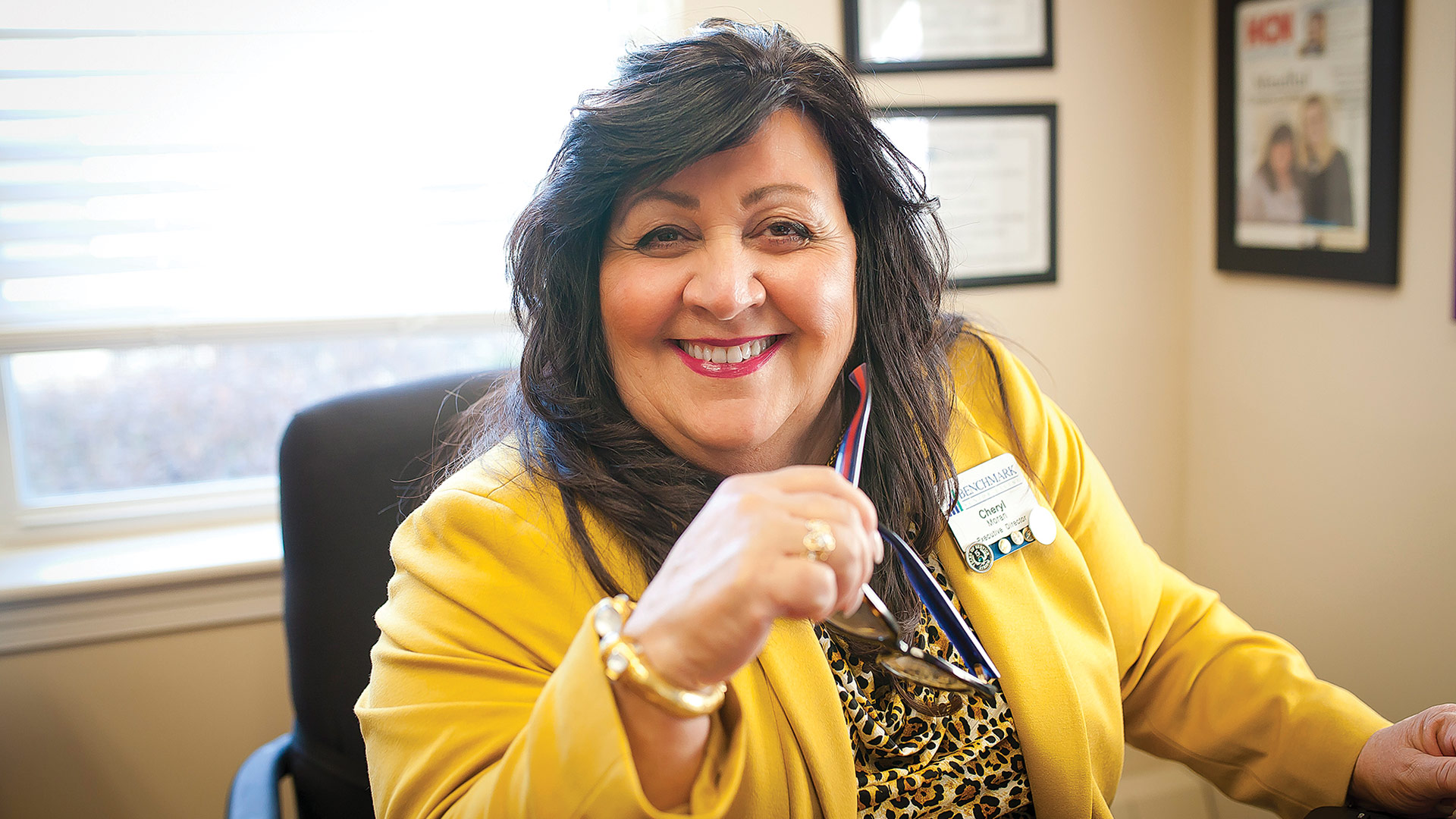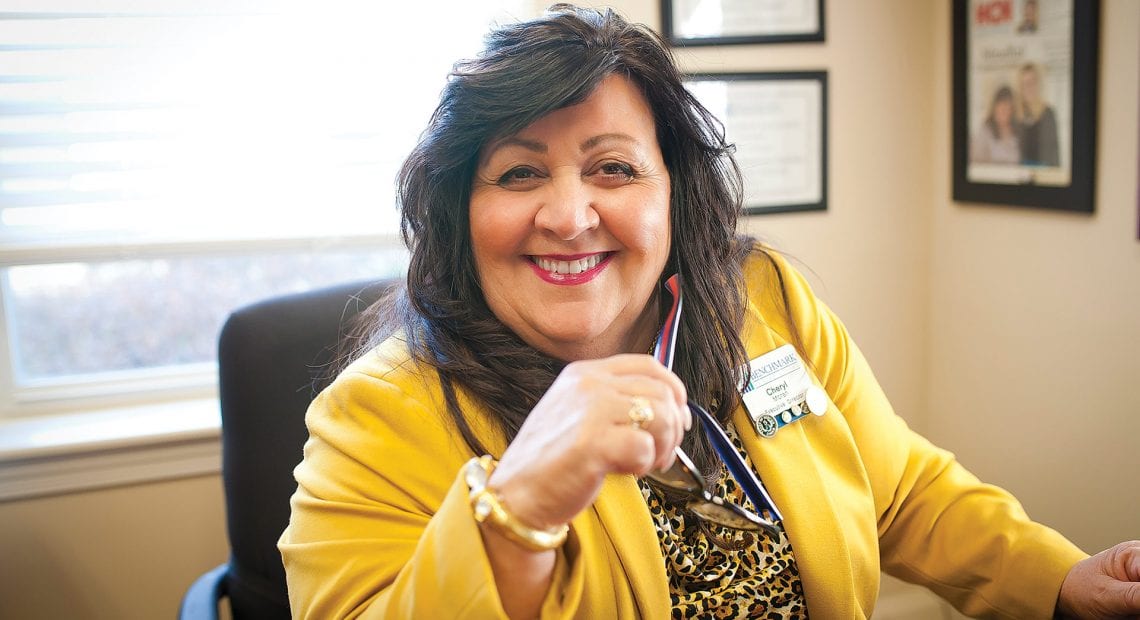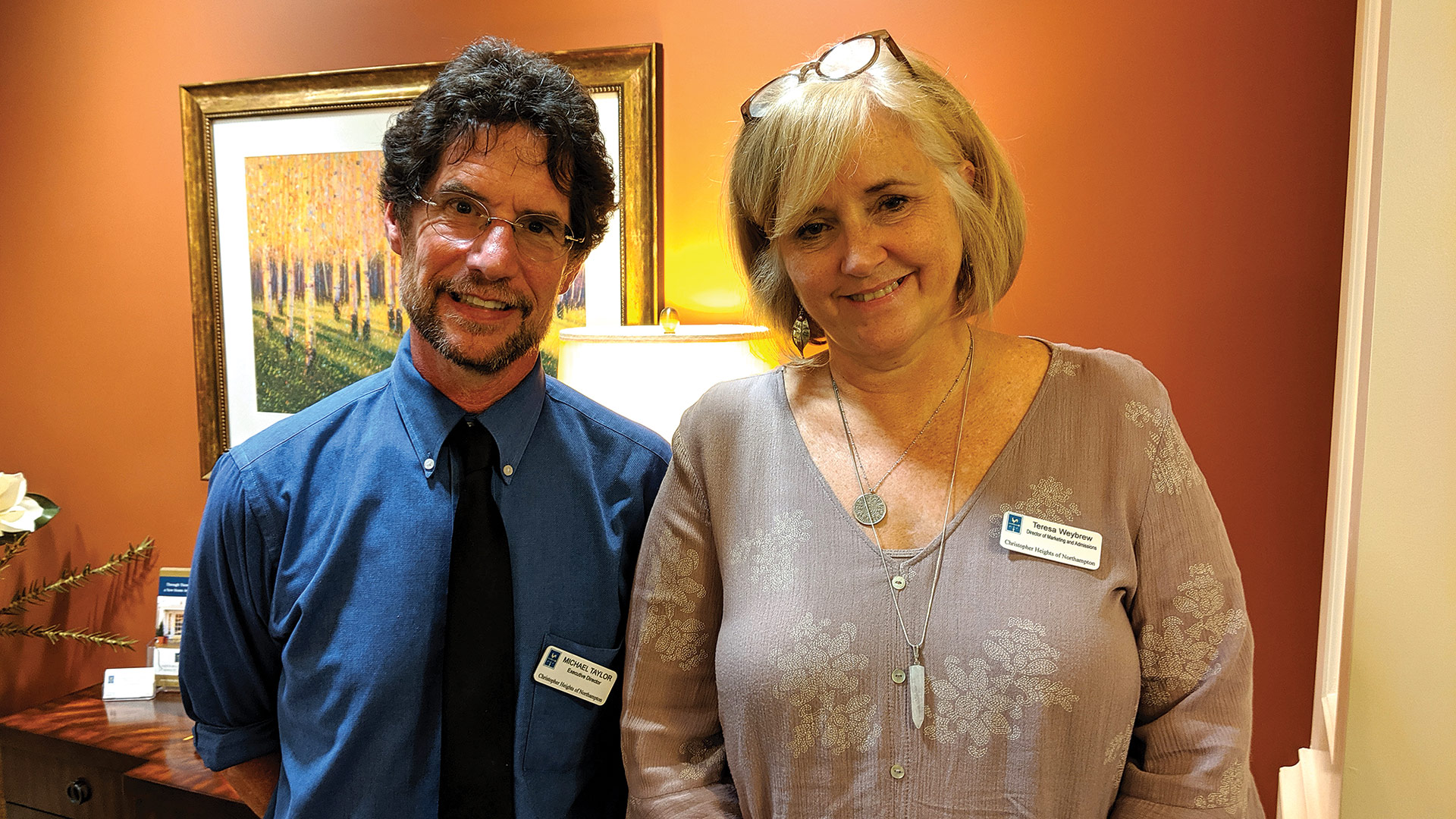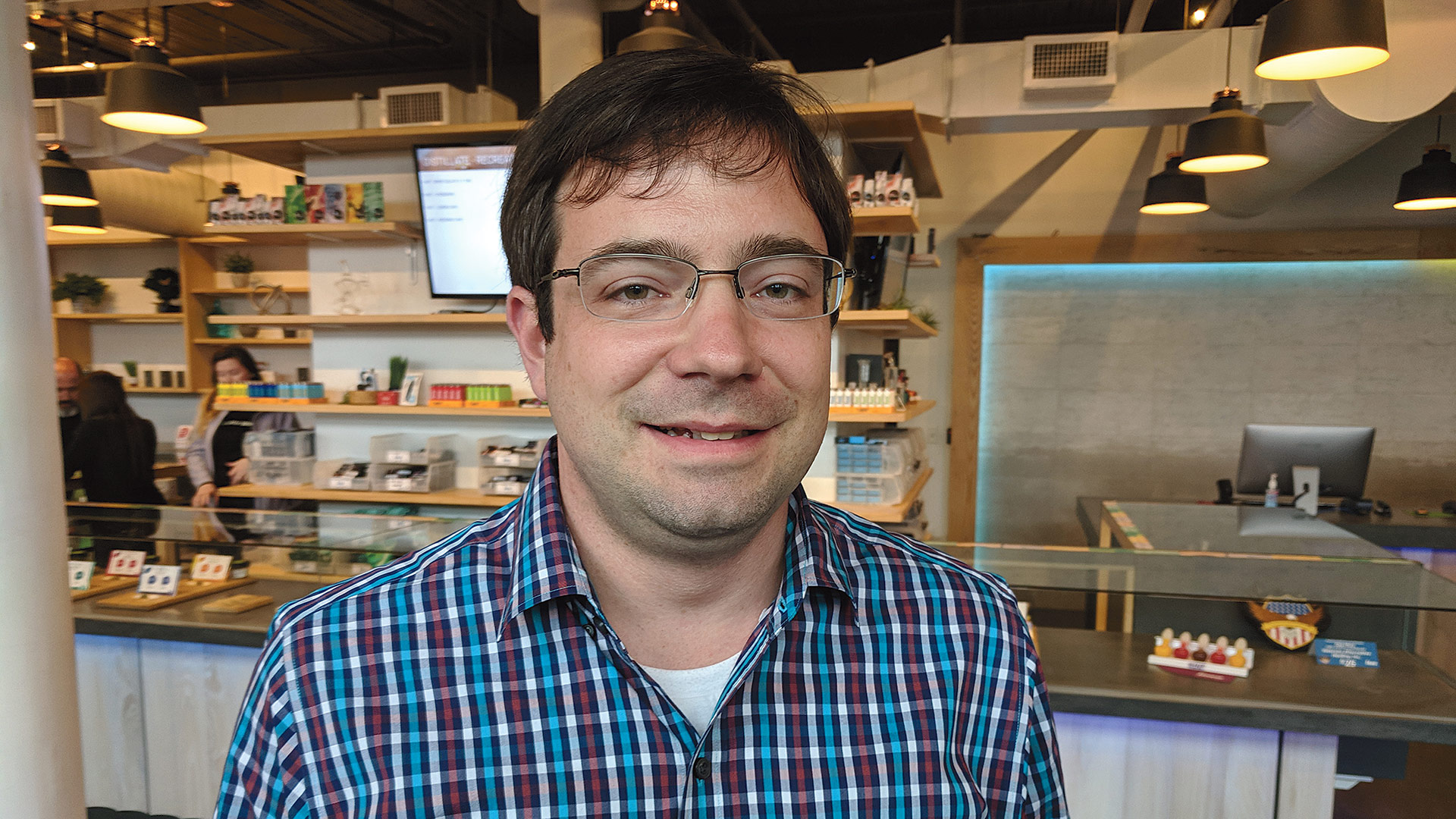Safe at Home
By Mark Morris

Cheryl Moran says she increased staffers’ hours and pay to make sure they worked only at the Atrium during the pandemic.
Beth Cardillo said the arrival of COVID-19 caused a “wildfire effect.”
As executive director of Armbrook Village, a senior-living community in Westfield that offers independent and assisted living, as well as memory care, Cardillo said the first days of the pandemic created huge challenges for healthcare professionals who faced major decisions while working with limited information.
For example, hospitals were only admitting COVID-positive patients if they had a fever and showed respiratory symptoms. Some seniors at Armbrook, however, were testing positive but manifesting different symptoms.
“We had someone who tested COVID-positive, but he didn’t have a fever or a respiratory problem,” she said. “He felt weak, fatigued, and he almost passed out.”
Cardillo’s call for an EMT to transport the positive-testing resident to the hospital was met with disappointment when she was told the hospital would not admit anyone for the coronavirus unless they had a fever or respiratory symptoms.
“At that time, no one knew there were a host of other symptoms,” she said. “It’s nobody’s fault because nobody knew.”
Cardillo informed Baystate Medical Center about residents who showed different symptoms for the coronavirus, and the hospital quickly sent a team of specialists in infectious disease and emergency medicine to Armbrook to further examine these cases.
“Incidents like this were happening all over the country,” Cardillo said. “It’s how we learned that people can manifest other symptoms but still have the coronavirus.”
Similarly, at the beginning of the pandemic, health officials were not encouraging everyone to wear masks; later, with better information, they shifted course. As information on all aspects of COVID-19 improved and safety guidelines were implemented across the U.S., senior-living facilities that already had sanitizing and infection protocols in place increased their efforts to battle the spread of coronavirus.
Emily Tamilio, Corporate Marketing director for Rockridge Retirement Community in Northampton, said her complex revamped its already-strong infection-control policies before the state went into lockdown. “We’ve redoubled our protocols and to make sure all our staff is up to date on proper infection control, hand washing, and strict sanitization procedures.”
Beth Cardillo
“We had someone who tested COVID-positive, but he didn’t have a fever or a respiratory problem. He felt weak, fatigued, and he almost passed out.”
Meanwhile, at Atrium at Cardinal Drive in Agawam — an assisted-living facility exclusively for people with memory loss — Executive Director Cheryl Moran imposed strict screening procedures to keep residents and staff safe, such as requiring all outside agencies to get her approval before they could enter the facility.
In the caregiving community, it’s not unusual for workers at one assisted-living facility to take a second part-time job at a similar site or earn additional income by providing care at a person’s home. Moran knew she had to address this vulnerability to keep the virus away. “I met with all our associates and offered more money, more hours, and different hours to encourage them to work only for the Atrium.”
Tamilio said Rockridge also offered additional pay and hours to keep staff working only at that facility. “Having our people just work for Rockridge was key to preventing transmission.”
Both Moran and Tamilio said encouraging staff to work only at one community is one of the main reasons neither campus has had any COVID-19 cases to date. It’s an example of how senior-living communities across Western Mass. had to be creative and aggressive — and continue to do so — to protect the most vulnerable population from a pandemic that’s far from over.
Visitation Consternation
In mid-March, the state issued guidelines for senior-living facilities to allow visitors only after they’ve had a health screening prior to their entry. When the pandemic first hit, all three communities BusinessWest spoke with said they restricted all outsiders except health providers and other essential personnel. Unfortunately, that meant families were not able to visit their loved ones in assisted living.
“As disappointing as that was, we had a solid communication process in place, and we were transparent about any changes, so it was much easier to get the families, residents, and staff on board,” Tamilio said.
Cardillo also stressed that communication was key, and personally checked in with every family member. “We were honest with people and let them know what was going on, and they appreciated that.”
As a further precaution for those in assisted living, the Executive Office of Elder Affairs mandated that everyone be quarantined in their apartments. No communal dining or walking around the halls was allowed.
Emily Tamilio
“We’ve redoubled our protocols and to make sure all our staff is up to date on proper infection control, hand washing, and strict sanitization procedures.”
Cardillo noted that many residents in assisted living have cognitive impairments that make processing and retaining information difficult, so structure and constant communication are very important. Still, cognitively impaired residents who had been making progress before the quarantine began to backslide.
“They were confused again, depression was setting in, and their anxiety increased,” she recalled. “In some ways, the social isolation was almost worse than the virus.”
Staff dressed in full personal protective equipment (PPE) began meeting one-on-one with each resident in their apartment. Cardillo said reaching out and having conversations with the residents began to make them feel better.
Moran said the configuration of the Atrium made it possible to allow residents out of their apartments and still keep them safe. “Because we have the space, we were able to socially distance our residents while still allowing them to take part in modified programs and activities.”
As late spring arrived and the weather improved, residents in most communities were able to go outside more often and socialize with others. Cardillo said positive changes began to happen the minute residents were able to enjoy some fresh air. “Whether it was having a conversation or taking a walk or simply looking at the birds, we saw their depression and anxiety lessen once they could spend time outside.”
The warmer weather also enabled the facilities to resume family visits. Moran said the Atrium has a designated area for outdoor visits where families can schedule time with their loved ones either after breakfast or after lunch.
“We can only allow two family members at a time, and they have to wear masks,” she explained. “Unfortunately, they can’t hug or kiss their loved ones, so they do air hugs and things like that.”
Videoconferencing through platforms like Zoom, Skype, and FaceTime have been effective ways for families to stay connected — and send air hugs to their loved ones — when a physical visit is not possible. Tamilio said Rockridge staff will often work with families to coordinate a videoconference or even a phone call to help them feel connected during the pandemic.
“There are many times when our staff are the eyes and ears for the families of our residents, so we work very hard to stay in contact with them,” she told BusinessWest.
Using videoconferencing tools is one more way to be reassuring and transparent with families and staff, Moran added. “It’s important for families to know about the place where their mom and dad are living.”
Cardillo talked about a recent Zoom conference conducted like a town-hall meeting that included 80 resident family members, as well as Armbrook department heads. The purpose was to let everyone know what’s been done so far to keep residents healthy and engaged, and their plans going forward.
“Many family members had no idea about everything we’d gone through to keep their loved ones safe,” she said. “They want to do this type of meeting again.”
Meeting with potential new residents and their families is an important part of any senior-living community. The arrival of COVID-19 has moved much of that activity from in-person meetings to videoconferences. For families who want a tour of the facilities, Tamilio said virtual tours have been an effective alternative to an actual visit.
“We can connect them to our community and help them feel engaged,” she said. “Videoconferencing also allows us to bring together multiple family members from different locations to answer all their questions in one meeting.”
Cardillo is still able to meet with families in-person in Armbrook’s private dining area by using social distancing and requiring masks for everyone. Before the meeting, she will have a phone conversation and send information so that, when a family arrives for the meeting, they have some idea about the community.
“I will show them apartments, but we can’t wander around the building anymore,” she noted. “That’s the only thing that’s really changed.”
While Moran is not yet meeting in person, she depends on virtual tours and has identified a number of families willing to serve in an ambassador-type role.
“There are several family members of current and past residents who are willing to speak with new families about their experience here,” she said. “They are able to give their perspective on how things have been going for their loved ones.”
Winter Is Coming
Seven months into the pandemic, and with fall and winter coming, the Executive Office of Elder Affairs is allowing senior-living facilities to permit indoor visitation to specific areas of the building.
Moran said the Atrium will use office space in its main building to screen visitors and supply full PPE. She plans to limit visits to 30 minutes and restrict visitors to meeting in the front areas of the building.
A similar visitor policy will be in effect at Rockridge, which is about to install an air-purification system to use in common areas. The idea is to monitor air quality to make sure those areas are safe, especially as they begin to open the dining area and allow more visitors
“We are trying to find the right balance between mitigating risk and enhancing the quality of life for everyone here,” Tamilio said.
As the weather gets cooler, Cardillo is looking forward to bringing activities such as exercise classes indoors. There will be limits on the number of people who can participate at any one time, but that’s just part of life in these times.
She reflected on the challenges facilities like hers faced with the sudden arrival of the pandemic back in March, and how far they’ve come. “At the beginning, we were all learning together at the same time. With all that we’ve learned since then, we have a much better handle on things now.”
She said residents are in a much better frame of mind these days, with no COVID-19 cases reported in months.
All the administrators we spoke with said a spirit of cooperation — with everyone pitching in and constantly doing more than expected — has been a true highlight of these last six months. To acknowledge that spirit, Cardillo is planning a series of recognition ceremonies for her staff in the coming weeks.
“We had people who got very sick, and our staff did some beautiful things,” she said. “Sometimes it was just sitting with a resident and holding their hand. Their families were really touched by it.”
With the pandemic still a daily reality, Cardillo said she and her colleagues are better prepared if there is another flare-up of the virus.
“We hope it doesn’t happen, but we’re ready if it does.”










 After recreational marijuana use became legal in Massachusetts in 2016, the expectation was that retail stores would pop up quickly within a couple of years. That hasn’t happened, as the state — and host communities — have taken a deliberately measured approach to permitting. But with early returns strong from a few shops, and towns reporting solid tax benefits and no real community disruption, the pace of openings should begin to increase — and so will the economic benefits of this new industry.
After recreational marijuana use became legal in Massachusetts in 2016, the expectation was that retail stores would pop up quickly within a couple of years. That hasn’t happened, as the state — and host communities — have taken a deliberately measured approach to permitting. But with early returns strong from a few shops, and towns reporting solid tax benefits and no real community disruption, the pace of openings should begin to increase — and so will the economic benefits of this new industry.


